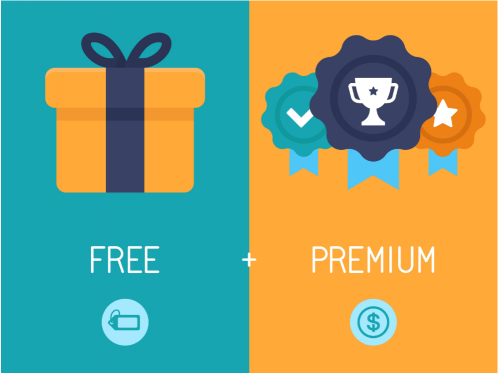Freemium model
Freemium: Free, Free, Free, but not one hundred percent Free. Have you ever been reading a very interesting article to only get halfway through and see: “You must subscribe to continue reading”? This is the crutch of the freemium model. They draw you in for free and then in order to move further along you must pay.
Freemium
The Freemium model has been around since the 1980s, although the term Freemium[1] came into use around 2006. The term was created by Jarid Lukin of Alacra. Freemium is a combination of the words free and premium. The freemium model is a business model where the product or service can be bought for free but in order to use other features you have to pay an additional cost. The freemium model comes in a variety of forms: video games, newspapers, storage sites like Dropbox, Amazon web services, etc. The freemium model is tier based one with a free tier and then successive tiers of paying for expanding features. Below is a list freemium products[2].
- Video Games(see below)
- Dropbox
- Amazon
- Spotify
- Wistia
- MailChimp
- Box
- OneDrive
- Evernote
- SurveyMonkey
- Skype
- Hootsuite
- Buffer
- Join.me
Video Games
The most common form of a freemium product is a video game. You acquire a game for free but it comes with many features that require in app purchases. This can range from a unique skin change to upgraded weapons that are unavailable without paying. The latter is a reason that some freemium games are also called Free to Play; Pay to Win games. This is one of the main ethical issues when it comes to this model. Below is a list of freemium games[3].
- Clash of Clans
- Clash Royale
- League of Legends
- The Room Two
- Crashlands
- Fortnite
- Apex Legends
- Counter Strike: Global Offensive
- Dungeons and Dragons Online
- etc
Ethical Issues
The freemium model is open to a whole series of ethical issues. Beginning with that their products are advertised has free, but in reality most have a cost to actually using said product. The ethical issue in this case is: are the producers of such products lying to their customers? In some of these products you can use it almost completely without having to pay, but in others you have only minimal functions for free.
Free to Play; Pay to Win maybe the biggest complaint with freemium games. This model of game gives a big incentive for paying for upgrades in order to better position yourself. It creates a never-ending cycle of kids seeing others pay to be better and then in turn these people pay to get on equal footing. One mobile app video game where this is very prominent is Clash of Clans. In Clash of Clans you can pay to get more resources that allow you to skip the normal wait time for upgrades. These in app purchases allow a player to become exponentially better at a fraction of the time. This type of game also preys on kids who have access to a parent or guardian’s credit card where they can spend hundreds of dollars before their guardian is even aware of the situation. This situation produces a couple of ethical issues, is it fair to other players to allow the game to essentially be pay to win and is it ethical for companies to be targeting an age range where the person may not understand the true monetary cost. The production companies use social pressures, showing players rank, to persuade kids into paying more money. Some examples of this issue: “A Belgian teenager spent $46,000 on purchasing in-game currencies using his grandfather’s card”[4], “A 7-year-old kid has recently spent almost $6,000 on the Jurassic World iPad game’s in-app purchases, including $2,200 spent in just one hour”[5], and “the 11-year old boy spent close to $7500 on virtual items, It took him very little time, too – $875 were gone in 5 minutes, then $1376 in half an hour.”[6] Some blame also has to be put on the customers here for not making it harder for their child to access their credit card.
Another ethical issue with freemium model is that companies do not always advertise the limited features you will be allowed to use if you only use the free version of said product. This restriction varies in multiple ways: limited features, limited capacity, limited use license, limited use time, and limited support. This is part of the strategy for this business model, hook the customer for free then introduce paying. Just as with the previous issue, this one can also be partly placed on the customer as most people tend to not read the fine print when acquiring a product.
References
- ↑ https://en.wikipedia.org/wiki/Freemium
- ↑ https://www.impactbnd.com/blog/10-phenomenal-freemium-models-that-are-putting-yours-to-shame
- ↑ https://www.google.com/search?rlz=1C1CHBF_enUS863US863&q=list+of+freemium+video+games&stick=H4sIAAAAAAAAAOOQMRIoSKxUKMlXKM_MU0hPzE0tjpLJySwuUchPU0grSk3NzSzNVSjLTEnNh8ieYuTVT9c3NEwzNS4sKStJP8XIpZ-rb2CSZ1xuVASTTDatME8xyaiESmZbJiVbGkA5GcZ5JuXJcGOyyisyTLPMoJJlBdlmSXBtVUaFBianGDlBHDODArh56ZVlhhnpvxgFAtCcvogVr9sB6fswMO4AAAA&sa=X&ved=2ahUKEwiIxsPY3JXoAhWHVc0KHTCTAUoQzTooADASegQIDBAC
- ↑ https://medium.com/@haishili0105/why-freemium-games-are-ethnical-problematic-8582ffff77b4
- ↑ https://www.iphoneincanada.ca/news/kid-spends-6000-in-app-purchases/
- ↑ https://www.phonearena.com/news/Kid-spends-7500-on-in-game-purchases-because-thats-what-kids-do-when-you-hand-them-an-iPad-and-unlimited-money_id92752
